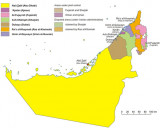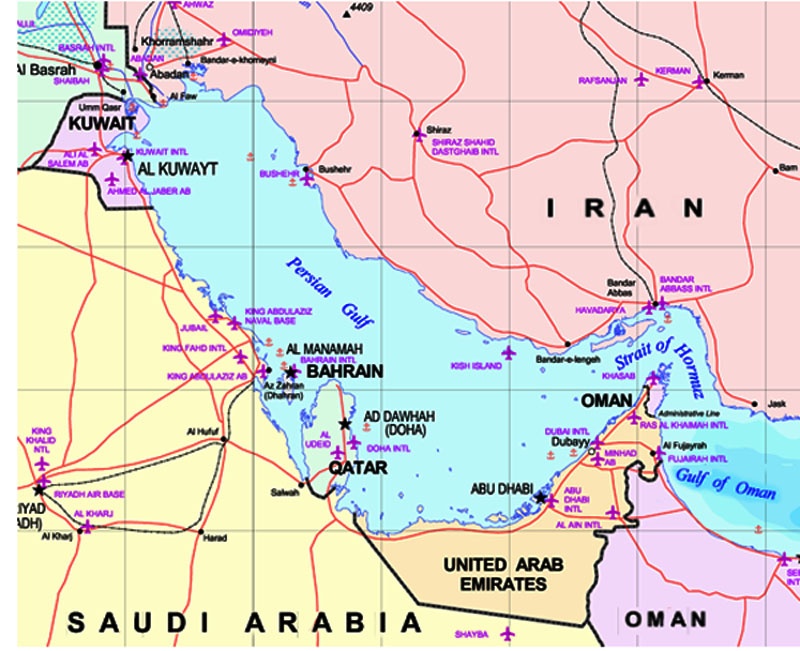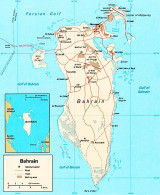

| Latitude | Longitude | |
| DMS | --- | --- |
| DM | --- | --- |
| DD | --- | --- |



 This inland sea of some 251,000 km² is connected to the Gulf of Oman in the east by the Strait of Hormuz; and its western end is marked by the major river delta of the Shatt al-Arab, which carries the waters of the Euphrates and the Tigris. Its length is 989 kilometres, with Iran covering most of the northern coast and Saudi Arabia most of the southern coast. The Persian Gulf is about 56 kilometres wide at its narrowest, in the Strait of Hormuz. The waters are overall very shallow, with a maximum depth of 90 metres and an average depth of 50 metres.In the Persian Gulf, the sea makes up quickly and is characterized by choppy waves, which are often all out of proportion to the wind force; the sea quickly subsides after a gale.
This inland sea of some 251,000 km² is connected to the Gulf of Oman in the east by the Strait of Hormuz; and its western end is marked by the major river delta of the Shatt al-Arab, which carries the waters of the Euphrates and the Tigris. Its length is 989 kilometres, with Iran covering most of the northern coast and Saudi Arabia most of the southern coast. The Persian Gulf is about 56 kilometres wide at its narrowest, in the Strait of Hormuz. The waters are overall very shallow, with a maximum depth of 90 metres and an average depth of 50 metres.In the Persian Gulf, the sea makes up quickly and is characterized by choppy waves, which are often all out of proportion to the wind force; the sea quickly subsides after a gale.Countries with a coastline on the Persian Gulf are (clockwise, from the north): Iran, Oman (exclave of Musandam), United Arab Emirates, Saudi Arabia, Qatar on a peninsula off the Saudi coast, Bahrain on an island, Kuwait and Iraq in the northwest.
Various small islands lie within the Persian Gulf, some of which are the subject of territorial disputes between the states of the region.
Persian Gulf is home to many small islands. Bahrain an island in the Persian Gulf, is itself a Persian Gulf Arab state. Geographically the biggest island in the Persian Gulf is Qeshm island located in the Strait of Hormuz and belonging to Iran. Other significant islands in the Persian Gulf include Greater Tunb, Lesser Tunb and Kish administered by Iran, Bubiyan administered by Kuwait, Tarout administered by Saudi Arabia, and Dalma administered by UAE. In recent years, there has also been addition of artificial islands,
often created by Arab states such as UAE for commercial reasons or as
tourist resorts. Although very small, these artificial islands have had a
negative impact on the mangrove
habitats upon which they are built, often causing unpredicted
environmental issues. Persian Gulf islands are often also historically
significant having been used in the past by colonial powers such as the Portuguese and the British in their trade or as acquisitions for their empires.
 Le Golfe Persique est une mer intérieure de 251 000 km qui est reliée à la mer d'Oman à l'E par le détroit d'Ormuz. Son extrémité W esr marquée par les grands delta du fleuve de Chatt al-Arab, qui transporte les eaux de l'Euphrate et le Tigris. Sa longueur est de 989 km, avec l'Iran couvrant la plupart de la côte N et de l'Arabie Saoudite la plupart de la côte S. Dans le Golfe Persique la mer se lève rapidement et se caractérise par des vagues courtes dont l'amplitude n'est pas en proportion avec la force du vent. La mer s'apaise rapidement après une tempête.
Le Golfe Persique est une mer intérieure de 251 000 km qui est reliée à la mer d'Oman à l'E par le détroit d'Ormuz. Son extrémité W esr marquée par les grands delta du fleuve de Chatt al-Arab, qui transporte les eaux de l'Euphrate et le Tigris. Sa longueur est de 989 km, avec l'Iran couvrant la plupart de la côte N et de l'Arabie Saoudite la plupart de la côte S. Dans le Golfe Persique la mer se lève rapidement et se caractérise par des vagues courtes dont l'amplitude n'est pas en proportion avec la force du vent. La mer s'apaise rapidement après une tempête.Le golfe Persique est large d'environ 56 km dans sa partie la plus étroite, le détroit d'Ormuz. Les eaux sont globalement très peu profonde avec une profondeur moyenne de 50 m et une profondeur maximale de 90 m.
Les pays ayant un littoral sur le golfe persique sont, en partant du N: l'Iran, Oman (enclave de Musandam), les Emirats Arabes Unis, l'Arabie Saoudite, le Qatar sur une presqu'ile de la côte saoudienne, Barhein, sur une île, le Koweït et l'Irak dans le NW.
Diverses petites îles se trouvent dans le Golfe Persique, dont certaines font l'objet de différents territoriaux entre les États de la région.
Bahreïn une île dans le golfe Persique, est en soi un Golfe Persique État arabe.
Géographiquement, la plus grande île du golfe Persique est l'île de Qeshm située dans le détroit d'Ormuz et d'appartenance à l'Iran.
D'autres îles importantes dans le golfe Persique comprennent la Grande Tumb , Petite Tumb et de Kish administrée par l'Iran, Bubiyan administrée par le Koweït, Tarout administrée par l'Arabie saoudite, et Dalma administrée par les EAU.
Ces dernières années, il y a des îles artificielles , souvent créés par des États arabes tels que les EAU pour des raisons commerciales ou touristiques. Bien que très petites, ces îles artificielles ont eu un impact négatif sur la mangrove, habitats dont ils sont construits, causant souvent des problèmes environnementaux imprévus.
Ebook | Persian Gulf - Arabian Gulf
|








